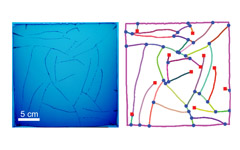Topology of fluid drainage fracture networks (Vol. 44 No. 5)
 Drainage fractures in gelatine layer. Blue circles – nodes, red squares – dead ends.
Drainage fractures in gelatine layer. Blue circles – nodes, red squares – dead ends.
Fluid generation in rocks is a common phenomenon: generation of hydrocarbons (oil\gas) from source rocks during diagenesis, dehydration of sedimentary and metamorphic rocks during burial and partial melting of the Earth’s mantle. Fluid generation leads to local increase in fluid pressure. If the rate of fluid production is high compared to the rate at which fluids can escape by flow through the initial permeability, the fluid pressure increases and may cause fracturing and creation of new fluid transport pathways.
This paper presents the development of fracture networks in a simple quasi-2D system consisting of a confined layer of gelatine containing yeast that consumes sugar to produce CO2. The topological properties of the emerging fracture networks were found to be intermediate between the tree-like structure of river networks and the fragmentation cracking patterns observed in drying muds, domain splitting during rock weathering and fracturing of cooling basalts. The ratio of the number of dead ends to the amount of nodes is ~0.4, between the ratio for rivers (=1) and fragmentation crack patterns (=0). Understanding of fluid drainage network topology is crucial for uncovering the mechanisms which lead to its formation.
M. Kobchenko, A. Hafver, E. Jettestuen, O. Galland, F. Renard, P. Meakin, B. Jamtveit and D. K. Dysthe, ‘Drainage fracture networks in elastic solids with internal fluid generation’, EPL, 102, 66002 (2013)
[Abstract]







